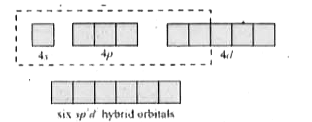Using valence bond theory explain geometry, hybridisation and magnetic property of [CoF6]−3 (Atomic number of Co = 27).Solution in Kannada
In this complex, the oxidation state of Co is +3. The electronic configuration of cobalt in +3 oxidation state is [Ar]3d64s0.
Orbitals of Co3+ ion are represented as

Since F− ion provides a weak ligand field, one 4s, three 4p and two outer 4d-orbitals hybridised to yield six sp.d hybrid orbitals pointing towards the six corners of an octahedron.

These six hybridised orbitals of Co3+ overlaps with orbitals of six F−ligands and six pairs of electrons donated by six F-to form six coordinate bonds.

Six sp3d2 hybrid orbitals with six pairs of electrons from ligands.
Thus, the complex has octahedral geometry. This complex is paramagnetic because of the presence of unpaired electrons,.
Topper's Solved these Questions
- BOOK - SUNSTAR PUBLICATIONCHAPTER - II PUC CHEMISTRY ( ANNUAL EXAM QUESTION PAPER MARCH - 2020)EXERCISE - PART-D32videos
II PUC CHEMISTRY ( ANNUAL EXAM QUESTION PAPER MARCH - 2020)
- BOOK - SUNSTAR PUBLICATIONCHAPTER - II PUC CHEMISTRY ( ANNUAL EXAM QUESTION PAPER MARCH - 2020)EXERCISE - PART-B10videos
II PUC CHEMISTRY ( ANNUAL EXAM QUESTION PAPER MARCH - 2020)
- BOOK - SUNSTAR PUBLICATIONCHAPTER - ANNUAL EXAM QUESTION PAPER MARCH-2019EXERCISE - PART-D28videos
ANNUAL EXAM QUESTION PAPER MARCH-2019
- BOOK - SUNSTAR PUBLICATIONCHAPTER - II PUC CHEMISTRY (ANNUAL EXAM QUESTION PAPER MARCH - 2014)EXERCISE - PART - D22videos
II PUC CHEMISTRY (ANNUAL EXAM QUESTION PAPER MARCH - 2014)
Similar Questions
Calculate the packing efficiency in Face Centred Cubic (FCC) structure.
02:32View SolutionCalculate the number of particles present per unit cell in a B.C.C unit cell
02:41View SolutionCalculate the packing efficiency in Face Centred Cubic (FCC) structure.
02:09View SolutionCalculate the packing efficiency in a simple cubic lattice.
05:18View SolutionValence bond theory explains the geometry and magnetic nature of the coordination compounds .
View SolutionExplain with the help of valence bond theory, the geometry and magnetic nature of [MnCl6]4−
03:19View SolutionWith the help of valence bond theory (VBT) , explain hybridisation geometry and magnetic behaviour of (NiCl_4)^(2-) complex .
05:54View SolutionOn the basis of valence bond theory, explain geometry, nature of hybridisation, magnetic property and optical isomerism of [Co(ox)3]3−and[CoF6]3−.
02:15View SolutionWith the help of Valence Bond Theory (VBT) explain hybridisation, geometry and magnetic property of [CoF_6]^2 heat fluoridocobaltate (III) ion.
View SolutionExplain the hybridisation, geometry and magnetic property of [Ni(Cl)4]2−.
View SolutionWith the help of Valence Bond theory account for hybridisation, geometry and magnetic property of [Ni(CN)4]2− complex ion [Z for Ni=28]
View SolutionUsing valence bond theory explain geometry, hybridisation and magnetic property of [CoF_6]_3^- (Atomic number of Co = 27).
05:48View SolutionExplain the hybridisation, mgnetic property, geometry, magnetic moment of [Ni(CO)4] using valence bondy theory.
View SolutionExplain the hybridisation, geometry, magentic property and magnetic moment of [Ni(CN)4]2− using valence bondy theory.
02:15View SolutionUsing VB theory, explain the type of hybridisation , geometry , magnetic property and magnetic moment of [Fe(CN)_(6)]^(3-)
03:19View Solutionవేలన్స్ బంధ సిద్ధాంతాన్ని ఉపయోగించి అణువుల జ్యామితిని ఎలా వివరిస్తారు?
02:15View Solution

